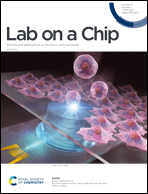Tough, permeable and biocompatible microfluidic devices formed through the buckling delamination of soft hydrogel films†
Abstract
Microchannels in soft materials play an important role in developing movable, deformable, and biocompatible fluidic systems for applications in various fields. Intensively investigated approaches to create microscale channel architectures use mechanical instability in soft materials, which can provide intricate yet ordered architectures with low cost and high throughput. Here, for microchannel fabrication, we demonstrate the use of swelling-driven buckle delamination of hydrogels, which is a mechanical instability pattern found in compressed film/substrate layer composites. By spatially controlling interfacial bonding between a thin polyacrylamide (PAAm) gel film and glass substrate, swelling-driven compressive stress induces buckle delamination at programmed positions, resulting in the formation of continuous hollow paths as microchannels. Connecting flow tubes with a 3D-printed connecter provides a deformable microfluidic device, enabling pressure-driven flows without leakage from the connecter and rupture of the channels. Furthermore, by stacking less-swellable bulk gels on the device, we obtained a tough, permeable, and biocompatible microfluidic device. Finally, we performed a cell culture on the device and chemical stimulation to cells through the diffusion of molecules from the microchannels. The results of this work shed light on designing pressure sensitive/resistant microfluidic systems based on diverse hydrogels with intricate 3D morphologies and will be useful for applications in the fields of bioanalysis, biomimetics, tissue engineering, and cell biology.



 Please wait while we load your content...
Please wait while we load your content...